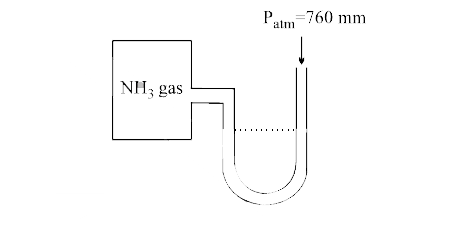An open ended mercury mnometer is used to measure the pressure exerted by a trapped gas as shown in the figure. Initially manometer shows no difference in mercury level in both columns as shown in diagram.

After sparking A dissociates according to following reaction:
2A(g)→3B(g)+2C(g) ltbr> If pressure of Gas A decreases to 0.8 atm. Then:
(Assume temperature to be constant at 300K)
total pressure increased by 1.3 atm
total pressure increased by 0.3 atm
total pressure increased by 22.3 cm of Hg
difference in mercuty level is 228mm
The correct Answer is:bd
Step by step video, text & image solution for An open ended mercury mnometer is used to measure the pressure exerted by a trapped gas as shown in the figure. Initially manometer shows no difference in mercury level in both columns as shown in diagram. After sparking A dissociates according to following reaction: 2A(g)rarr3B(g)+2C(g) ltbr. If pressure of Gas A decreases to 0.8 atm. Then: (Assume temperature to be constant at 300K) by Chemistry experts to help you in doubts & scoring excellent marks in Class 11 exams.
Updated on:21/07/2023Topper's Solved these Questions
Similar Questions
A manometer attached to a flask contains NH3 gas have no difference in mercury level initially as shown in diagram.After the sparking into the flask, it have difference of19 cm in mercury level in two columns.Calculate % dissciation of ammonia

View SolutionHeat of reaction A(s)+B(g)→2C(g) is 40 kJ at 300 K and constant volume. Hence, heat of reaction at constant pressure and at 300 K is,
View Solution
Knowledge Check
A open ended mercury manometer is used to measure the pressure exerted by a trapped gas as shown in the figure. Initially manometer shows no difference in mercury level in both columns as shown in diagram.

After sparking 'A' dissociates according to following reaction
A(g)→B(g)+3C(g)
If pressure of Gas "A" dissociates to 0.9 atm, then (Assume temperature to be constant and is 300 K)Atotal pressure increases to 1.3 atmBtotal pressure increases by 0.3 atmCtotal pressure increases by 22.3 cm of HgDdifference in mercurry level is 228 mm.A manometer attached to a flask contains with ammonia gas have no difference in mercury level initially as shown in diagram. After sparking into the flask, ammonia is partially dissociated as 2NH3 (g)→N2 (g)+3H2 (g) now it have difference of 6 cm in mercury level in two columns, what is partial pressure of H2 (g) at equilibrium?
 A9 cm HgB18 cm HgC27 cm HgDNone of these
A9 cm HgB18 cm HgC27 cm HgDNone of theseAn experiment is done as shown in diagram then final pressure after stop cock is opened.
[Assume reaction : NH3(g)+HCl(g)→NH4Cl(s) ]
 A3 atmB13 atmC1 atmD1.5 atm
A3 atmB13 atmC1 atmD1.5 atm
Consider the following first order reaction,
2A(g) → 2B(g) + C(g)
Starting with pure A having pressure 2 atm initially, the total pressure is 3 atm after 2 hrs. Then total pressure after 4 hrs will be :
View SolutionAn inert gas is added to the following equilibrium,
A(s)+2B(g)⇔3C(g)
at constant pressure. The equilibrium
View SolutionFor a first order gas phase reaction :
A(g)→2B(g)+C(g)
P0 be initial pressure of A and Pt the total pressure at time 't'. Integrated rate equation is :
View SolutionFor reaction
2A(g)+3B(g)→4C(g)+D(s) Calulate work involved during system reaction if reaction occurs at constant pressure and 300K:
View SolutionFor the first order reaction A(g)→2B(g)+C(g), the initial pressure is PA=90 mm Hg, the pressure after 10 minutes is found to be 180 mm Hg. The rate constant of the reaction is
View Solution
